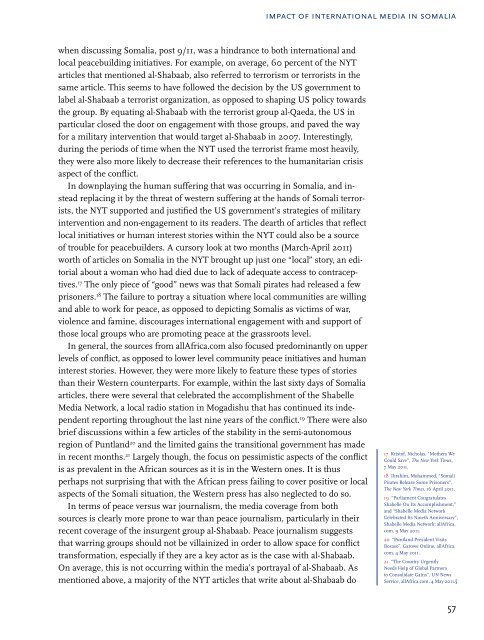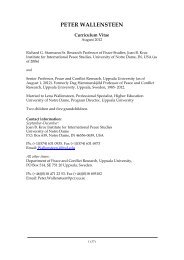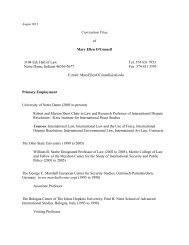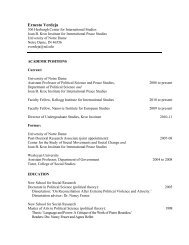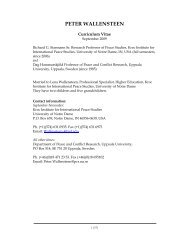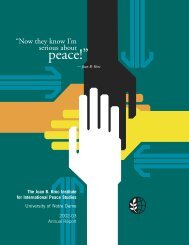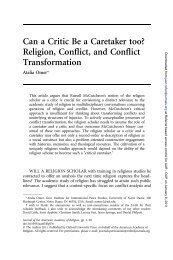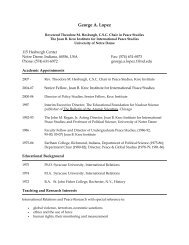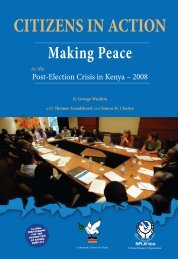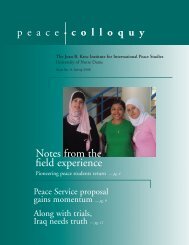Somalia: Creating Space for Fresh Approaches to Peacebuilding
Somalia: Creating Space for Fresh Approaches to Peacebuilding
Somalia: Creating Space for Fresh Approaches to Peacebuilding
You also want an ePaper? Increase the reach of your titles
YUMPU automatically turns print PDFs into web optimized ePapers that Google loves.
impact of international media in somalia<br />
when discussing <strong>Somalia</strong>, post 9/11, was a hindrance <strong>to</strong> both international and<br />
local peacebuilding initiatives. For example, on average, 60 percent of the NYT<br />
articles that mentioned al-Shabaab, also referred <strong>to</strong> terrorism or terrorists in the<br />
same article. This seems <strong>to</strong> have followed the decision by the US government <strong>to</strong><br />
label al-Shabaab a terrorist organization, as opposed <strong>to</strong> shaping US policy <strong>to</strong>wards<br />
the group. By equating al-Shabaab with the terrorist group al-Qaeda, the US in<br />
particular closed the door on engagement with those groups, and paved the way<br />
<strong>for</strong> a military intervention that would target al-Shabaab in 2007. Interestingly,<br />
during the periods of time when the NYT used the terrorist frame most heavily,<br />
they were also more likely <strong>to</strong> decrease their references <strong>to</strong> the humanitarian crisis<br />
aspect of the conflict.<br />
In downplaying the human suffering that was occurring in <strong>Somalia</strong>, and instead<br />
replacing it by the threat of western suffering at the hands of Somali terrorists,<br />
the NYT supported and justified the US government’s strategies of military<br />
intervention and non-engagement <strong>to</strong> its readers. The dearth of articles that reflect<br />
local initiatives or human interest s<strong>to</strong>ries within the NYT could also be a source<br />
of trouble <strong>for</strong> peacebuilders. A cursory look at two months (March-April 2011)<br />
worth of articles on <strong>Somalia</strong> in the NYT brought up just one “local” s<strong>to</strong>ry, an edi<strong>to</strong>rial<br />
about a woman who had died due <strong>to</strong> lack of adequate access <strong>to</strong> contraceptives.<br />
17 The only piece of “good” news was that Somali pirates had released a few<br />
prisoners. 18 The failure <strong>to</strong> portray a situation where local communities are willing<br />
and able <strong>to</strong> work <strong>for</strong> peace, as opposed <strong>to</strong> depicting Somalis as victims of war,<br />
violence and famine, discourages international engagement with and support of<br />
those local groups who are promoting peace at the grassroots level.<br />
In general, the sources from allAfrica.com also focused predominantly on upper<br />
levels of conflict, as opposed <strong>to</strong> lower level community peace initiatives and human<br />
interest s<strong>to</strong>ries. However, they were more likely <strong>to</strong> feature these types of s<strong>to</strong>ries<br />
than their Western counterparts. For example, within the last sixty days of <strong>Somalia</strong><br />
articles, there were several that celebrated the accomplishment of the Shabelle<br />
Media Network, a local radio station in Mogadishu that has continued its independent<br />
reporting throughout the last nine years of the conflict. 19 There were also<br />
brief discussions within a few articles of the stability in the semi-au<strong>to</strong>nomous<br />
region of Puntland 20 and the limited gains the transitional government has made<br />
in recent months. 21 Largely though, the focus on pessimistic aspects of the conflict<br />
is as prevalent in the African sources as it is in the Western ones. It is thus<br />
perhaps not surprising that with the African press failing <strong>to</strong> cover positive or local<br />
aspects of the Somali situation, the Western press has also neglected <strong>to</strong> do so.<br />
In terms of peace versus war journalism, the media coverage from both<br />
sources is clearly more prone <strong>to</strong> war than peace journalism, particularly in their<br />
recent coverage of the insurgent group al-Shabaab. Peace journalism suggests<br />
that warring groups should not be villainized in order <strong>to</strong> allow space <strong>for</strong> conflict<br />
trans<strong>for</strong>mation, especially if they are a key ac<strong>to</strong>r as is the case with al-Shabaab.<br />
On average, this is not occurring within the media’s portrayal of al-Shabaab. As<br />
mentioned above, a majority of the NYT articles that write about al-Shabaab do<br />
17 Kris<strong>to</strong>f, Nicholas, “Mothers We<br />
Could Save”, The New York Times,<br />
7 May 2011.<br />
18 Ibrahim, Mohammed, “Somali<br />
Pirates Release Some Prisoners”,<br />
The New York Times, 16 April 2011.<br />
19 “Parliament Congratulates<br />
Shabelle On Its Accomplishment,”<br />
and “Shabelle Media Network<br />
Celebrated Its Nineth Anniversary”,<br />
Shabelle Media Network; allAfrica.<br />
com, 9 May 2011.<br />
20 “Puntland President Visits<br />
Bosaso”, Garowe Online, allAfrica.<br />
com, 4 May 2011.<br />
21 “The Country Urgently<br />
Needs Help of Global Partners<br />
<strong>to</strong> Consolidate Gains”, UN News<br />
Service, allAfrica.com, 4 May 2011.§<br />
57


